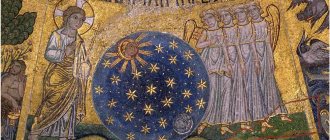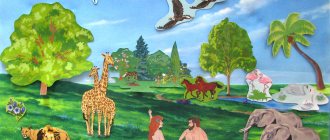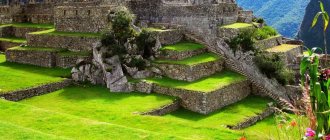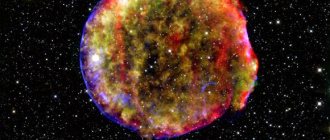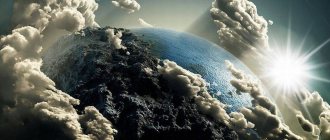Who and how created the Earth and created the structure of the world familiar to us? What does Holy Scripture tell us and how do contemporaries interpret it?
At all times, people argue and continue to debate about the origin of all living and nonliving things on the planet. There are thousands of interpretations and views on the origin of earthly life. One of the most popular among the Orthodox population is the biblical story of the creation of the world.
In this material you will learn about how and who created our world, why it contains such living microorganisms, plants, seas and oceans, earth and sky, sun and clouds. We will deal with the changes in the first interpretations of the Holy Scriptures in modern times and dispel the myths that the development of microorganisms and microbes was the reason for the emergence of man.
world creation
In the beginning God created the heaven and the earth. The earth was formless and empty, and darkness was over the deep, and the Spirit of God hovered over the waters.
(Genesis 1, 1–2).
The biblical teaching about the creation of the world is briefly called the Six Days . Day means day. In 1823, Anglican priest George Stanley Faber (1773–1854) put forward the day-age theory. This opinion has absolutely no basis. In Hebrew, the word olam is used to express an indefinite period of time or era. The word yom in Hebrew always means day, day, but never a period of time. Rejecting a literal understanding of the day greatly distorts the biblical teaching about the creation of the world. If we take the day as an era, then how to determine evening and morning? How to apply the blessing of the seventh day and the rest in it to the era? After all, the Lord commanded rest on the seventh day of the week—the Sabbath—because He Himself rested: and God blessed the seventh day and sanctified it, for on it He rested from all His works (Gen. 2:3). The Lord created plants on the third day, and the sun, moon and other luminaries on the fourth. If we accept the idea of \u200b\u200bday - era, it turns out that plants grew without sunlight for an entire era.
The Holy Fathers understood the day of the first chapter of the book of Genesis literally. Saint Irenaeus of Lyons : “Restoring this day in Himself, the Lord came to suffer on the day before Saturday - that is, on the sixth day of creation, on which man was created, through His suffering giving him a new creation, that is, (liberation) from death.” Saint Ephraim the Syrian : “No one should think that the six-day creation is an allegory.” Saint Basil the Great : “And there was evening, and there was morning, one day... defines the measure of day and night and combines into one daily time, because twenty-four hours fill the continuation of one day, if by day we mean night.” Saint John of Damascus : “From the beginning of one day to the beginning of another day is one day, for the Scripture says: both there was evening and there was morning: one day.”
How then did the alternation of day and night occur before the creation of the luminaries, which appear on the fourth day? St. Basil the Great writes: “Then, not by the movement of the sun, but by the fact that this primeval light, in a measure determined by God, either spread out, then contracted again, day occurred and night followed” (Six Day Conversation 2).
The book of Genesis begins with a description of God's magnificent work of creating the world in six days. The Lord created the Universe with countless luminaries, the earth with its seas and mountains, man and the entire animal and plant world. The biblical revelation about the creation of the world rises above all existing cosmogonies of other religions, just as truth rises above any myth. Not a single religion, not a single philosophical doctrine could rise to the idea of creation out of nothing that surpasses reason: In the beginning God created the heavens and the earth.
God is self-sufficient and absolutely complete. For His existence, He does not require anything and does not need anything. The only reason for the creation of the world was the perfect Love of God. Saint John of Damascus writes: “The good and most good God was not content with contemplating Himself, but out of the abundance of His goodness He wanted something to happen that in the future would benefit from His benefits and be involved in His goodness.”[1]
The first to be created were disembodied spirits - Angels . Although the Holy Scriptures do not contain a narrative about the creation of the angelic world, there is no doubt that Angels by their nature belong to the created world. This view is based primarily on the clear biblical understanding of God as the omnipotent Creator who laid the foundation for all that exists. Everything has a beginning, only God is beginningless. Some holy fathers see an indication of the creation of the invisible world of angels in the words God created the heavens (Genesis 1:1). In support of this thought, Saint Philaret (Drozdov) notes that, according to the biblical narrative, the physical heaven was created on the second and fourth days.
The primeval land was unsettled and empty. Created from nothing, matter first appeared disordered and covered in darkness. Darkness was an inevitable consequence of the absence of light, which was not created as an independent element. Further, the writer of life Moses writes that the Spirit of God hovered over the waters (Genesis 1, 2). Here we see an indication of the creative and life-giving participation in creation of the third Person of the Holy Trinity - the Holy Spirit. An extremely short and precise definition - everything is from the Father through the Son in the Holy Spirit. Water mentioned in the above verse is the most important element without which life is impossible. In the Holy Gospel, water is a symbol of the life-giving and saving teachings of Jesus Christ. In the life of the Church, water has a special meaning, being the substance of the Sacrament of Baptism.
First day of creation
And God said: Let there be light. And there was light... And God separated the light from the darkness. And God called the light day and the darkness night. And there was evening and there was morning: one day (Gen. 1:3-5).
By Divine command, light . From further words: and God separated the light from the darkness, we see that the Lord did not destroy the darkness, but only established its periodic replacement with light to restore and preserve the strength of man and every creature. The Psalmist sings of this wisdom of God: You spread darkness and there is night: during it all the forest animals roam; lions roar for prey and ask God for food for themselves. The sun rises [and] they gather and lie down in their lairs; a man goes out to his work and to his work until evening. How numerous are Your works, O Lord! (Ps 103:20-24). The description of the creative deeds of each of the six days ends with a poetic expression. The word saints' day itself was taken literally.
World creation. Day 1,2,3. Nativity Cathedral in Mytishchi. Photo by O. Savichev
Light was created by the Divine word , possessing omnipotent creative power: for He spoke, and it was done; He commanded, and it appeared (Ps 33:9). The Holy Fathers see here a mysterious indication of the second Person of the Holy Trinity - the Son of God Jesus Christ, whom the Apostle calls the Word and at the same time says: All things came into being through Him, and without Him nothing began to be that was made (John 1:3).
When describing the first day, evening is put first, and then morning. For this reason, the Jews in biblical times began their day in the evening. This order was preserved in the worship of the New Testament Church.
Second day of creation
And God created the firmament... <...> and called... the firmament heaven (Genesis 1:7, and placed the sky between the water that was on the earth and the water above the earth.
and placed the sky between the water that was on the earth and the water above the earth.
On the second day, God created the physical heaven . The word firmament conveys the word of the Hebrew original, meaning spread out, for the ancient Jews metaphorically compared the firmament to a tent: you stretch out the heavens like a tent (Ps 103:2).
When describing the second day, we also talk about water, which is found not only on the earth, but also in the atmosphere.
Third day of creation
And God gathered the waters under the sky into one place and opened the dry land. And he called the dry land earth, and the collection of waters he called seas. And God commanded that the earth should grow greenery, grass and trees bearing fruit. And the earth was covered with vegetation. The Lord separated the water from the dry land (see: Gen. 1:9–13).
On the third day, oceans, seas, lakes and rivers , as well as continents and islands were created . Later, this caused delight in the Psalmist: He gathered up the waters of the sea like heaps, and placed the deep in storehouses. Let all the earth fear the Lord; let all who live in the universe tremble before Him, for He spoke, and it was done; He commanded, and it appeared (Ps 33:7-9).
On the same day, God created the entire plant world . This was fundamentally new: God laid the foundation for organic life on earth.
commanded the earth to produce flora . Saint Basil the Great says: “The then verb and this first command became, as it were, a natural law and remained in the earth for subsequent times, giving it the power to give birth and bear fruit” (St. Basil the Great. Six Days. Conversation 5).
The book of Genesis says that the earth brought forth grass, grass, and trees, yielding seed according to their kinds . The Holy Fathers attached fundamental importance to this, for it indicates the constancy of everything created by God: “What came out of the earth at the first creation is preserved to this day, through the preservation of the race by succession” (St. Basil the Great. Six Days. Conversation 5). As you can see, the third day was dedicated to the structure of our planet.
And God saw that it was good (Genesis 1:12). The writer of everyday life expresses in poetic language the idea that God creates wisely and perfectly.
Fourth day of creation
And God said that lights should appear in the firmament of heaven to sanctify the earth and to separate day from night. The calendar and time will now be counted based on the created luminaries. And the luminaries appeared: the sun, the moon and the stars (see: Gen. 1, 14–18).
In the description of the fourth day we see the creation of the luminaries, their purpose and their differences. From the text of the Bible we learn that light was created on the second day before the luminaries, so that, according to the explanation of St. Basil the Great, unbelievers would not consider the sun to be the only source of light. God alone is the Father of lights (see: James 1:17).
World creation. Day 4,5,6. Nativity Cathedral in Mytishchi. Photo by O. Savichev
The creation of luminaries had three purposes: first, to illuminate the earth and everything on it; a distinction is established between the luminaries of the day (the sun) and the luminaries of the night (the moon and stars). Secondly, separate day from night; distinguish between four seasons , organize time using a calendar and keep chronology. Thirdly, to serve for signs of the end times; this is spoken of in the New Testament: the sun will be darkened, and the moon will not give its light, and the stars will fall from the sky, and the powers of the heavens will be shaken; then the sign of the Son of Man will appear in heaven; and then all the tribes of the earth will mourn and see the Son of Man coming on the clouds of heaven with power and great glory (Matthew 24:29-30).
Fifth day of creation
On the fifth day, the Lord created the first living creatures living in water and flying in the air. And God said: Let the water bring forth living things; and let the birds fly over the earth. This is how the inhabitants of the waters appeared, aquatic animals, insects, reptiles and fish appeared, and birds flew through the air (see: Gen. 1, 20–21).
At the beginning of the fifth day, God turns His creative word to water (let water produce), while on the third day - to the earth. The word water is taken in this place in a broader sense, denoting not only ordinary water, but also the atmosphere, which the sacred writer also calls water.
On the fifth day, God creates a higher form of life than plants. By God's command, representatives of the water element appeared (fish, whales, reptiles, amphibians and other inhabitants of the waters), as well as birds, insects and everything living in the air.
The Creator creates the first beings of each kind (“according to kind”). He blesses them to be fruitful and multiply.
Sixth day of creation
On the sixth day of creation, God created animals living on earth and man in His image and likeness (see: Gen. 1, 24–31).
the description of the sixth creative day with the same words as the previous days (the third and fifth): let him produce... God commands the earth to create all the animals of the earth (a living soul according to its kind). God created everything in a certain sequence of increasing perfection .
And the Lord God created man from the dust of the ground, and breathed into his nostrils the breath of life , and man became a living soul (see: Gen. 1:26-28).
Man was created last, as the crown of creation . He was created in a special way. The Holy Fathers first of all note that his creation was preceded by the Divine Council between all the Persons of the Most Holy Trinity: Let us create man. Man is distinguished from the entire created world by the way the Lord creates him. Although his bodily composition was taken from the earth, the Lord does not command the earth to produce man (as was the case with other creatures), but He Himself creates him directly. The psalmist says, turning to the Creator: Thy hands have created me and formed me (Ps 119:73).
God said that it is not good for man to be alone.
And the Lord God caused the man to fall into a deep sleep; and when he fell asleep, he took one of his ribs and covered that place with flesh. And the Lord God created a wife from a rib taken from a man, and brought her to the man (Genesis 2:21-22).
The Lord, of course, could have created not only one married couple, but several and produced from them the entire human race, but He wanted all the people of the earth to be one in Adam. After all, even Eve was taken from her husband. The Apostle Paul says: From one blood He made the whole human race to dwell on all the face of the earth (Acts 17:26). And that's why we are all relatives.
At the dawn of human history, God established marriage as a permanent life union between a man and a woman. He blessed him and bound him with the closest bonds: they will become one flesh (Gen. 2:24).
Having created the human body, God breathed into his face the breath of life , and man became a living soul. The most important distinguishing feature of a person is that his soul is godlike . God said: Let us make man in our image [and] after our likeness (Genesis 1:26). about what the image of God is in man . When God created man, He brought all the animals and birds to him, and man gave them all names. The naming of names was a sign of man's dominance over all creation.
World creation. The creation of man. Church of the Nativity of the Virgin Mary in Kostino
With the creation of man, the six-day creation of the world ends. God created the world perfect . The hand of the Creator did not bring any evil into him. This doctrine of the original goodness of all creation is a sublime theological truth.
At the end of time will be restored. According to the testimony of the seer, the holy Apostle John the Theologian, there will be a new heaven and a new earth (see: Rev. 21:1).
Seventh day
And God finished His work that He had done on the seventh day, and He rested on the seventh day from all His work that He had done (Gen. 2:2).
Having completed the creation of the world, God rested from His works. The writer of everyday life uses a metaphor here, for God does not need rest. This indicates the secret of true peace that awaits people in eternal life. Before the arrival of this blessed time, already in earthly life we see a prototype of this state - the peace of the blessed seventh day, which in the Old Testament was Saturday , but for Christians is Sunday .
What modern science says
In the scientific world, it is generally accepted that the Universe originated as a result of the Big Bang. This theory is based on the fact that energy and matter (the foundations of all things) were previously in a state of singularity. It, in turn, is characterized by infinity of temperature, density and pressure. The state of singularity itself rejects all the laws of physics known to the modern world. Scientists believe that the Universe arose from a microscopic particle, which, for reasons still unknown, came into an unstable state in the distant past and exploded. But for now this is just talk. There is no more or less plausible theory of this beginning of the creation of the world. But then, from the first seconds, everything becomes more or less clear and understandable. And, oddly enough, it is confirmed by observed data. Here's the story: more than 13 billion years have passed, but traces remain.
CMB radiation
It all started in 1965, when two employees of the American company Bell Telephone, Arno Penzias and Robert Wilson, designed a new ultra-sensitive antenna operating in a certain frequency range. All this work was done for use in the field of satellite communications and telecommunications. Designed. Built.
But then something bad happened. There was interference. Some strange noise. The guys looked for its source, but could not find it. It came from all directions. In desperation, they published an article in one of the radio engineering magazines, in which they described their development in detail and asked the community of engineers working in this field to express their guesses as to what could be the reason for this strange phenomenon.
Nobody said anything. And then this is what happened: radio astronomers (and at that time astronomical observations were already carried out at different frequencies, and not only in the ranges accessible to the eye, as in past times) saw this article. Accidentally. They were simply looking through radio engineering magazines to see what new things these engineers would come up with that would be useful for their research. Read it. And they grabbed their heads. By all the parameters described, this was IT. The same relict radiation! Its characteristics coincided with everything predicted by astrophysics theorists. Since the time of Gamow. In 1978, Penzias and Wilson received the Nobel Prize for their discovery, and the Big Bang theory became generally accepted in the scientific world.
Explanation of observations
But the fact remained a fact. An explanation for it was already proposed in the 50s by the remarkable American physicist of Russian origin, Georgiy Gamow (the boy’s parents took him out of Russia after the revolution). This explanation was, as they say in physics, “on the fingers”, without any formulas. He said: imagine a balloon that gradually inflates and becomes bigger and bigger, and these small round stickers are stuck on its surface. So, if these two stickers are located next to each other, then as the balloon inflates they will move away from each other, but not quickly. And the greater their distance from each other, the higher the speed of divergence will be.
This is explained by simple formulas available to every high school student. But we won’t cite them here. As Hawking wrote, the fewer formulas in popular science material, the better it is perceived by the reader. Just imagine this inflating balloon - and everything will become clear. That's the whole solution to the Hubble paradox. The farther the observed object (galaxy) is from us, the faster it runs away from us. This means that the Universe, like that balloon, is expanding.
Only one question remains. What does Gamow's ball and our Universe have to do with it? Well, ball, this is for the public. In fact, Gamow may have been the first to come up with the theory of an expanding universe. And if it expanded, it means it had some kind of beginning.
Expanding Universe theory
After this, the theorists got down to business. And not immediately, but the picture of the development of the Universe was restored. But one thing was missing. According to all the proposed models, at the earliest stages of development, only radiation existed in the Universe (this, by the way, was established by Gamow). Only later, when the Universe expanded to a decent size and the temperature in it dropped, elementary particles began to appear, then atoms consisting of them, and then everything else that we are now observing. But traces of this primary radiation (it is now called relict radiation) should have remained. Its parameters (of this residue) have been theoretically established. But there was no trace of him. And then they were found. This, by the way, is a very interesting story, which is an excellent example of the “mysterious paths” of the development of science.
Chronology of the development of the Universe
So how did this happen from the point of view of modern science? And like this. Brief chronology. The Big Bang happened. Our Universe arose. Such a small, invisible lump. What happened next from the moment of the explosion.
- 10-45 - 10-37 seconds - inflationary expansion, as a result of which space expanded immeasurably. An inquisitive reader may ask. What about the theory of Relativity? There is also the speed of light, which cannot be exceeded. And everything is very simple. The limitations of the theory of Relativity apply to the movements of any material objects in our space. And then the space itself expanded.
- Then, when space expanded, quarks and electrons first appeared in it, and then other elementary particles.
- Atoms were formed approximately 400 thousand years after the Beginning.
- After billions of years, the first stars and galaxies were born, and then the planets.
- Well, after about ten to eleven billion years, life appeared on this planet Earth, which evolved into Homo sapiens.
How did we understand this
So how did humanity get to all this? A lot of things are being said about this now. But, according to the most popular version, it all started with the discovery of the American astronomer Hubble (the space telescope is now named after him). So, Hubble discovered the so-called red shift in the spectra of distant galaxies.
Here we need to tell you what we are talking about so that it is clear. All chemical elements, and in this case we are talking about hydrogen, from which all stars are mainly composed, emit electromagnetic waves. And the more this hydrogen heats up (and in stars where thermonuclear reactions take place, it is very hot), the more it emits.
But here’s the trick. This radiation comes at certain frequencies. And with a certain amplitude at each frequency. So, having received the appropriate information (there is such a science - spectroscopy), you can unambiguously determine which chemical elements are present in the object you are observing. It's like fingerprints.
And when, in the 20s of the last century, the developed instruments made it possible to study the spectra of matter in distant galaxies, Hubble discovered an amazing phenomenon. The further away the observed galaxy was, the stronger the so-called red shift was observed. The spectra were normal in structure. Hydrogen and hydrogen. But in terms of frequencies they were shifted to the so-called red side of the spectrum.
For theoretical physics of that time there was nothing strange about this - the Doppler effect. If an object moves away from you, the spectrum shifts to the red. If it gets closer, then, on the contrary, it turns purple.
But how could these data be in accordance with the stationary model of the Universe? And why, as subsequent observations showed, the further away the object under study was, the stronger the red shift? Did this object fly away from us faster? From what bells and whistles?
Evolution of the Universe
So how did this all happen? How did our Universe evolve? What will happen to her next? Of these three questions, only the second one now has a clear answer. There are different opinions on the first question and the third. But for now this is so - “la-la poplars”. And we will not retell them.
So, how did our Universe evolve after the Big Bang? There were several stages in its development.
But before listing them, the following should be noted. In the understanding of most people who have heard something about this “Big Bang”, it happened like this. There was something, let's call it space, and then something exploded in it. And from this came what we see now.
Whether this is true or not. What was there before the “Big Bang” and whether it was there at all (that means it was there if something exploded), no one knows. But we must understand, although it is very difficult to understand and imagine, that as a result of the “Big Bang” not only matter was formed, but also the very space and time in which we live. So much for the creation of the world. Truly a creation, truly a world. The world, in the sense of space, time and the matter existing in it.
Dark things
Now, the main mysteries are the nature of the so-called dark matter and dark energy.
We already mentioned dark energy in a previous article. This is antigravity, which expands our Universe. Its nature has not yet been established. But the fact of existence is irrefutably proven.
And also dark matter. Observations of galaxies have shown that the stars in them rotate much faster than calculations predicted. At first, scientists assumed that there were supermassive “black holes” at the centers of galaxies. They really are there. Although it is impossible to observe them. They do not emit electromagnetic waves. And they don’t emit anything at all. That's why they are called black. Their existence was predicted by the General Theory of Relativity (GTR), and then, based on indirect evidence, they were discovered and their existence is now beyond doubt.
So here it is. The observed movement of stars in galaxies did not explain the existence of “black holes”.
But the advent of powerful supercomputers made it possible to solve the so-called “inverse problem” in mathematics. Namely, to calculate the presence and distribution of centers of gravity of matter in the galaxy, providing the observed motion of stars. And it turned out that these centers of attraction must be distributed in a certain way throughout the entire observable space. But they could not be found. Nowhere. This incomprehensible entity was called dark matter. Its nature has not yet been established.
Well, why do we care about all this? It's simple. Dark energy and dark matter account for 95% of everything in the Universe! And we more or less know about the remaining 5%, and these are all observable galaxies with their stars, dust nebulae, streams of elementary particles and other “living creatures”. So there is something to work on.
